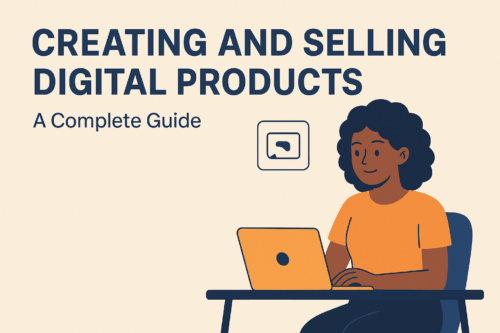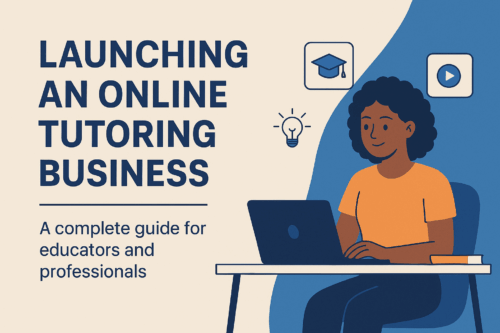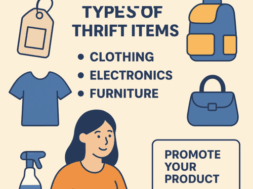Creative Industries: Opportunities, Trends, and Challenges in 2025

The creative industries are rapidly becoming a driving force in today’s economy. Unlike traditional businesses, creativity-driven ventures thrive on passion, innovation, and personal expression. With the rise of digital platforms, online marketplaces, and social media, individuals are finding new ways to monetize their skills and reach global audiences. From fashion and crafts to music, art, and photography, the creative world is no longer just about hobbies—it is a thriving sector with immense potential.
In 2025, we see entrepreneurs transforming ideas into sustainable brands, while consumers increasingly demand authenticity, uniqueness, and personal storytelling. Let’s explore the major industries within this ecosystem, the opportunities they hold, and the challenges to overcome.
Fashion Entrepreneurship
Trendy Opportunities
Fashion has always been a central pillar of creativity. In 2025, trends like streetwear, thrift reselling, and custom-made designs dominate the market. Thrift reselling is gaining momentum as Gen Z and millennials lean toward sustainable choices. Similarly, eco-conscious buyers are driving demand for eco-friendly fabrics, recycled materials, and slow fashion.
For entrepreneurs, starting with a small clothing collection or capsule wardrobe is a cost-effective way to build brand identity. Rather than mass production, focusing on uniqueness and quality helps establish trust.
Selling Platforms
The rise of Instagram Shops, Etsy, and Shopify has made it easier than ever for small brands to enter the market. Platforms like Depop, Poshmark, and Jumia Fashion allow entrepreneurs to reach fashion-conscious buyers globally.
Growth Hacks
Collaborating with influencers and fashion bloggers is one of the fastest ways to scale. Pair this with targeted advertising, storytelling, and showcasing behind-the-scenes design processes to engage customers.
Crafts & Handmade Products
Profitable Craft Ideas
Crafts remain one of the most accessible and profitable ventures for creative entrepreneurs. Popular items include jewelry, scented candles, pottery, and home décor pieces. Consumers appreciate unique handmade gifts that offer personalization and authenticity, which mass-produced items lack.
Where to Sell
Craft makers can sell through Etsy, Amazon Handmade, local artisan markets, and craft fairs. These platforms allow sellers to tap into audiences actively searching for personalized and handmade goods.
Marketing Strategies
One of the strongest strategies is storytelling—customers love knowing the inspiration behind each piece. Showcasing the crafting process on TikTok, Pinterest, or Instagram Reels creates emotional connections and boosts sales.
Art Businesses
Ways to Monetize
For visual artists, the opportunities are diverse. Income can be generated from selling prints, digital downloads, and commissioned artworks. In addition, the digital revolution has brought forward NFTs (non-fungible tokens), allowing artists to sell original digital works with verified ownership.
Selling Platforms
Traditional and modern platforms both matter. Artists use Redbubble, Society6, DeviantArt, Behance, and Dribbble for exposure and sales. For NFTs, platforms like OpenSea and Rarible continue to dominate.
Personal Branding
A strong online portfolio is essential for credibility. Branding isn’t just about selling art—it’s about presenting yourself as a professional. Building a personal brand helps artists secure commissions, collaborations, and long-term fans.
Music Entrepreneurship
Earning Streams
Music is no longer limited to live performances. In 2025, musicians earn income through Spotify, Apple Music, SoundCloud, YouTube, and Bandcamp. Other revenue streams include selling beats, licensing music for commercials, and producing jingles for advertisements.
Promotion Tools
TikTok and Instagram Reels have become crucial for music marketing, often propelling songs to viral status. Live performances, collaborations with other artists, and partnerships with event organizers also expand visibility and income.
Photography Businesses
High-Demand Niches
Photography remains a profitable field, with opportunities in weddings, events, portraits, and stock photography. Specialized niches like drone photography, food styling, and real estate shoots are increasingly in demand.
Selling Options
Photographers can monetize through Shutterstock, Adobe Stock, and Getty Images, or build direct income by selling through their personal websites and online portfolios.
Marketing Tips
Platforms like Instagram and Pinterest serve as visual marketing hubs. Showcasing creative portfolios, offering limited-time deals, and combining photography with videography services increases profitability.
Building a Creative Brand
Core Elements
In the creative industries, branding is more than a logo—it’s a story. Successful brands invest in storytelling, consistent online presence, and strong networking with other creatives. Diversifying income by offering both digital and physical products ensures long-term growth.
Future Trends
Looking forward, innovations such as AI-generated art, AR/VR experiences, and digital fashion are reshaping the sector. Creatives who adopt these trends early can capture new audiences and gain a competitive edge.
Challenges & Solutions
Common Issues
Despite the opportunities, creative entrepreneurs face significant hurdles. These include:
- Balancing creativity with business demands
- Copyright and intellectual property issues
- Market saturation and intense competition
- Finding and retaining target audiences
Solutions
Overcoming these challenges requires both strategic thinking and resilience. Learning about copyright laws, registering original works, and using contracts protect intellectual property. Focusing on niche markets and authentic brand storytelling helps stand out in a crowded marketplace.
Case Studies: Creative Entrepreneurs Thriving in 2025
Fashion Example
Take the rise of thrift resellers on Depop and Instagram Shops. Many young entrepreneurs begin with just a few carefully sourced second-hand items. By styling, photographing, and marketing them as unique fashion pieces, sellers grow loyal audiences. Some have scaled into full sustainable clothing brands, leveraging Shopify to manage global orders.
Crafts Example
In the craft world, a simple handmade jewelry shop on Etsy can transform into a six-figure business. By offering personalized items, telling stories about materials used, and showing behind-the-scenes videos, crafters stand out against mass-produced products.
Art Example
Digital artists are also succeeding by offering commissioned work on Behance or Dribbble, while simultaneously listing art prints on Redbubble. Meanwhile, others are entering the NFT space, selling exclusive digital art on OpenSea.
Music Example
Independent musicians who once struggled to secure record deals are now monetizing via YouTube, Spotify, and Bandcamp. Many combine this with TikTok marketing, where short song snippets can go viral and generate millions of streams overnight.
Photography Example
Photographers often begin as freelance event shooters, later diversifying into stock photography on Adobe Stock or Shutterstock. Some expand into video production, offering bundled services to corporate clients or weddings, doubling their income streams.
Tips for Building a Successful Creative Business
1. Start Small, Scale Smart
Many creatives think they need large investments to begin. In reality, starting with small collections, a single service, or digital offerings allows entrepreneurs to test the market with minimal risk.
2. Master Storytelling
Every customer wants a story. Whether it’s a fashion designer sharing their inspiration, a musician discussing the meaning behind lyrics, or a photographer explaining their creative process, storytelling builds emotional connections.
3. Leverage Digital Platforms
In 2025, visibility is everything. Use platforms where your target audience spends time—Instagram and TikTok for visuals, Etsy for crafts, Spotify for music, and Behance for design portfolios.
4. Diversify Income Streams
Don’t rely on one channel. For example:
- A fashion brand can sell clothes and create tutorials on YouTube.
- An artist can sell prints and offer digital commissions.
- A musician can stream music and license beats.
- A photographer can shoot weddings and sell stock photos.
5. Build a Loyal Community
Customer loyalty isn’t just about discounts. It’s about engagement, transparency, and value. Offer referral programs, behind-the-scenes content, or subscription services to keep audiences coming back.
The Future of Creative Industries
Technology Integration
- AI tools are simplifying design, editing, and music production, allowing creatives to produce more efficiently.
- AR and VR experiences are merging art, music, and storytelling, creating immersive exhibitions and concerts.
- Digital fashion is growing in popularity as virtual worlds and metaverses expand.
Global Market Access
Thanks to e-commerce platforms, even small creative businesses can reach international buyers. A craftsperson in Ghana or a photographer in India can now sell to customers in New York, Paris, or Tokyo with ease.
Consumer Shifts
Modern consumers value authenticity, personalization, and sustainability. Brands that focus on eco-friendly practices, fair trade, and inclusivity are winning over younger generations.
Challenges to Anticipate
1. Oversaturation
The creative industry is competitive. To stand out, focus on niche markets and develop a unique selling proposition (USP) that highlights what makes your brand different.
2. Protecting Intellectual Property
With digital distribution comes the risk of content theft. Creatives must copyright their work, use watermarks, and understand IP laws to safeguard their earnings.
3. Balancing Art and Business
Many creatives struggle to balance passion with profit. Learning basic business skills—budgeting, marketing, and project management—ensures sustainability.
4. Economic Instability
Rising costs of materials and shifts in consumer spending can impact sales. The key is adaptability—diversifying offerings and embracing online sales helps cushion these risks.
Monetizing Creativity Beyond Traditional Models
Subscription-Based Support
Platforms like Patreon and Ko-fi allow creatives to build recurring income by offering exclusive content to fans. Whether it’s early access to songs, behind-the-scenes videos, or limited-edition artwork, subscriptions build stable revenue while deepening audience engagement.
Workshops & Online Classes
Knowledge-sharing is becoming just as profitable as creating. Creatives can host online workshops via Zoom, Udemy, or Teachable, teaching skills such as painting, songwriting, or jewelry-making. This not only positions them as experts but also provides scalable income.
Brand Collaborations
Businesses are increasingly partnering with independent creatives to tap into their originality. A fashion influencer may collaborate with eco-brands on capsule collections, while a musician may license tracks for advertisements. These collaborations expose creatives to new audiences and revenue streams.
How to Market a Creative Business in 2025
Harness Social Media Trends
Platforms like Instagram Reels, TikTok, and YouTube Shorts are reshaping how audiences discover new talent. Creatives who adapt to short-form content—showing process videos, storytelling, or quick tips—gain higher visibility and engagement.
Optimize SEO for Discoverability
An online presence isn’t complete without SEO. Artists, musicians, and fashion brands must optimize websites, product listings, and blogs with keywords like “sustainable fashion trends 2025” or “profitable crafts to sell online.”
Email Marketing for Loyalty
While social media captures attention, email marketing builds lasting relationships. Sending updates, discounts, or sneak peeks ensures audiences stay connected even if algorithms change.
Influencer & Peer Collaboration
Cross-promotion with other creatives boosts credibility. A painter collaborating with a photographer, or a musician teaming up with a videographer, creates bundled offerings that expand reach.
Global Opportunities for Creatives
E-commerce Expansion
Thanks to Shopify, Etsy, and Amazon Handmade, even micro-businesses can ship products worldwide. Affordable logistics and digital payments via PayPal, Stripe, and Flutterwave have made cross-border selling seamless.
Tourism & Local Markets
Creative entrepreneurs also thrive locally. For instance, street fashion sellers at festivals or artisans at craft fairs attract both tourists and locals, building brand visibility.
Cultural Exports
Many creatives are gaining traction by blending local heritage with modern trends. African designers, for example, are using traditional prints in streetwear, while Asian artisans are reviving ancient pottery with modern twists. This cultural authenticity sets them apart globally.
The Role of Technology in Creative Industries
AI as a Creative Tool
Artificial intelligence is no longer a threat—it’s an ally. Tools like ChatGPT, DALL·E, and AI music generators assist in idea development, editing, and prototyping. Creatives who use AI wisely free up time for higher-level artistry.
Blockchain for Transparency
Beyond NFTs, blockchain technology helps creatives track ownership, prove authenticity, and manage royalties fairly. Musicians, for instance, can receive instant micropayments when their tracks are streamed.
Virtual & Augmented Reality
Immersive experiences are reshaping entertainment. Artists can host virtual galleries in VR, musicians can perform concerts in the metaverse, and fashion brands can sell digital clothing for avatars.
You can also read on: https://baobabentrepreneur.com/?p=3765
Practical Steps for Aspiring Creatives
- Identify Your Niche – Decide whether you’re best suited for fashion, music, art, photography, or crafts.
- Start Lean – Use cost-effective tools and platforms to test your business idea before scaling.
- Build a Portfolio – Whether through Instagram, Etsy, or a personal website, showcase your work professionally.
- Invest in Branding – From logos to storytelling, brand identity sets you apart.
- Engage Consistently – Post regularly, share your journey, and respond to your audience.
- Measure Growth – Track analytics on platforms to see what works and double down on it
Final Thoughts
The creative industries of 2025 present extraordinary opportunities for entrepreneurs willing to merge passion with strategy. Fashion brands can rise from thrift reselling; artists can monetize through prints and NFTs; musicians can thrive via streaming and licensing; and photographers can diversify income streams globally.
Yet, the golden rule remains: authenticity wins. Consumers today want meaningful connections, unique creations, and ethical businesses. Creatives who stay authentic while embracing digital platforms, new technologies, and smart marketing will not just participate in the industry—they will shape its future.
Conclusion
The creative industries in 2025 are thriving more than ever, fueled by innovation, digital tools, and the global demand for authentic products and services. From fashion and crafts to music, art, and photography, opportunities abound for those ready to take the leap.
Success in this sector isn’t reserved for a select few—it belongs to those who blend creativity with smart strategy. By starting small, leveraging digital platforms, telling powerful stories, and building loyal communities, creatives can transform passion into profitable businesses.
As technology continues to reshape the landscape, the future of creative entrepreneurship promises even more exciting possibilities. The key is to stay authentic, adapt to trends, and always keep the customer at the heart of your brand.
















